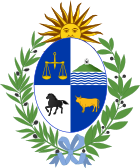 |
|---|
A constitutional referendum was held in Uruguay on 30 November 1958 alongside general elections. [1] Two proposals for amendments to the constitution were put to voters, but both were rejected.
 |
|---|
A constitutional referendum was held in Uruguay on 30 November 1958 alongside general elections. [1] Two proposals for amendments to the constitution were put to voters, but both were rejected.
Proposal 1 was put forward by the Ruralista/Herrerista faction of the National Party through the General Assembly, and proposed a presidential system of government, separating the presidential and parliamentary elections, and abolishing the lema system. [1]
Proposal 2 was put forward by the Civic Union through a popular initiative, and proposed introducing a presidential system of government. [1]
| Choice | Votes | % |
|---|---|---|
| Proposal 1 | 235,941 | 23.04 |
| Proposal 2 | 153,662 | 15.01 |
| Against both | 634,080 | 61.95 |
| Total | 429,760 | 100 |
| Registered voters/turnout | 1,158,939 | 37.08 |
| Source: Direct Democracy | ||